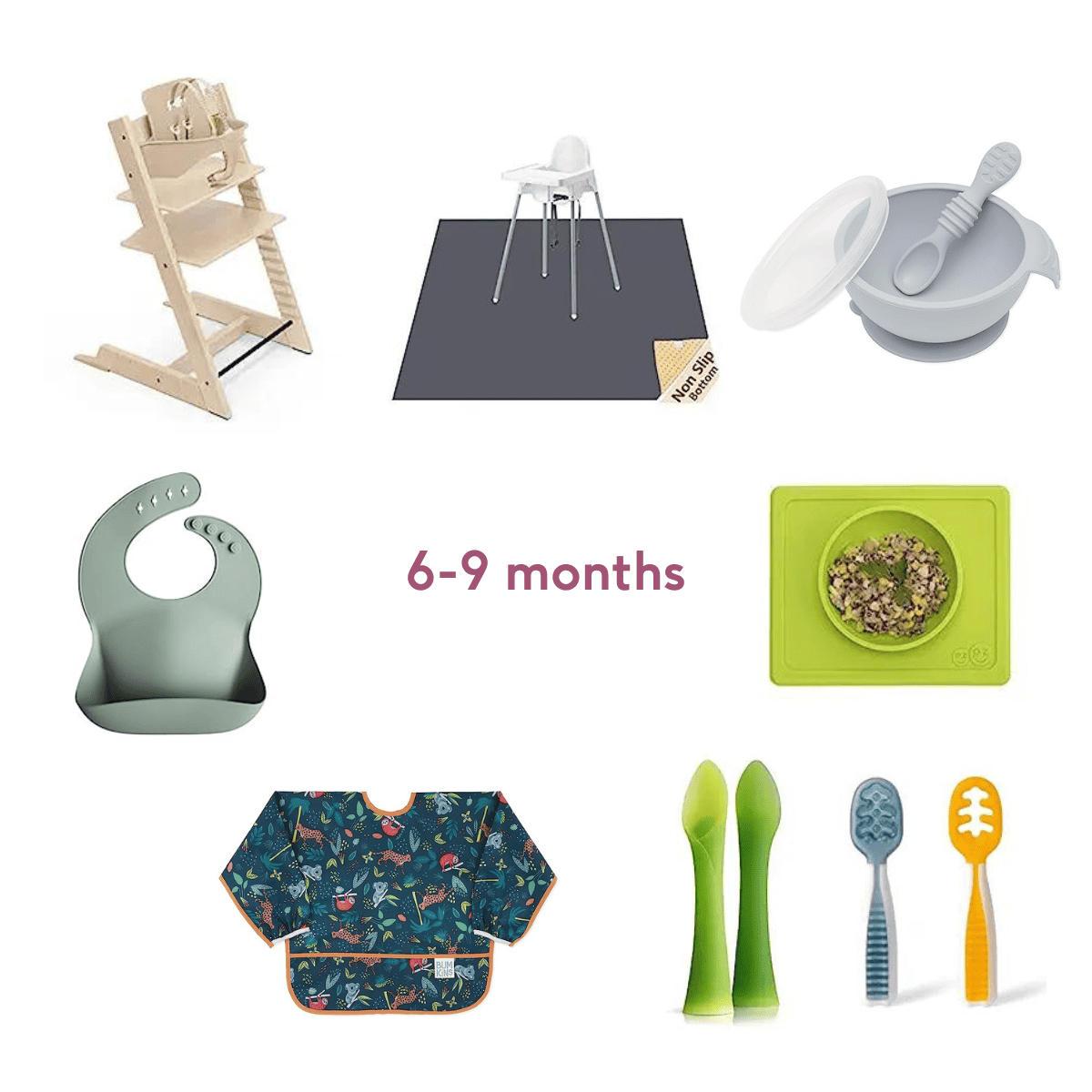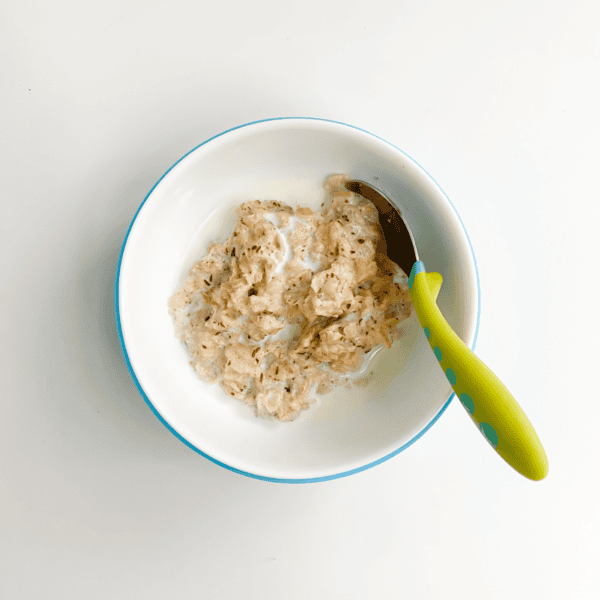What You Need to Know About Heavy Metals in Baby Food
Apr 17, 2024, Updated May 26, 2025
This post contains affiliate links. Please see our disclosure policy.
No one wants to see the words “heavy metals” and “baby food” in the same sentence.
I totally get it, many of the headlines we’ve seen lately are alarming!
There’s already so much to worry about and so much pressure with your baby. The last thing you want to worry about is something harmful lurking in their food.
Let’s look at what the current research ACTUALLY says, beyond the exaggerated headlines.
As a Registered Dietitian with a Master of Clinical Nutrition degree, and a kinda anxious mom, I never want parents to worry when they don’t need to!
Table of Contents
- What You Need to Know About Heavy Metals in Baby Food
- Baby Foods and Heavy Metals
- Why has this been in the news?
- The facts about heavy metals in baby food
- What are we doing about heavy metals in baby food?
- What are parts per billion (ppb)?
- In what dose are heavy metals harmful?
- Let’s pause and take a breather
- What about accumulation of heavy metals? Is that a thing?
- 8 ways to minimize heavy metal exposure and risk
- Clean Label Project
- Safe baby food
- Best organic safe baby food without heavy metals?
- Does homemade baby food have heavy metals?
- My favorite baby food and baby food brands
- The bottom line about heavy metals in baby foods
What You Need to Know About Heavy Metals in Baby Food
Baby Foods and Heavy Metals
While I was researching for this blog, I noticed a ton of google searches on “baby food with heavy metals.” There were also brand-specific searches like, “best baby food brand without heavy metals.”
Right away, this showed me how concerned parents are about this topic- and rightfully so! We want nothing more than to make sure that we’re doing right by our kids. A big component of that is making sure they’re healthy and nourished. And of course, that includes serving them safe baby food.

Let’s take a look at the science and the data.
Let’s talk about ingredients.
And I’ll also let you know some of my favorite brands/products for feeding babies and kids!
Before we go on, remember that there are always going to be people that make you feel like there are foods you should NEVER give your kid. And they’ll probably make you feel like you’re poisoning your kid for doing X, Y, or Z.
The fear mongering approach you’ve likely come across is almost never telling the whole story. I want to avoid that approach entirely. My goal is to arm you with actual evidence-based data and information on this super important topic.
Note: This post contains some affiliate links. As an Amazon affiliate, I earn from qualifying purchases at no cost to you.
Why has this been in the news?
In 2021, a report from the US House Committee on Oversight and Reform said, “commercial baby foods are tainted with dangerous levels of arsenic, lead, cadmium, and mercury.”
(Check out a summary of this report from Harvard.)
This obviously raised alarms for parents.
But let’s see what the report is saying and what it’s not saying.
“The report was based on information from just four companies that make baby food: Nurture, Beech-Nut, Hain, and Gerber. Arsenic, lead, and cadmium were found in baby foods from all of the companies; mercury was found in the food from the only company that tested for it (Nurture). Of note, three other companies (Walmart, Sprout, and Campbell’s Soup) were asked to provide the same information about their baby food products, and did not.”

So we can see right away, this report isn’t necessarily talking about ALL baby foods.
It tested a specific number of brands. We want to take these results seriously (and understand why this is the case in certain foods). We also want to resist the temptation to generalize them to every baby food brand.
The facts about heavy metals in baby food
There is something to know before we get into the facts a little more. Traces of heavy metals are found in nearly all foods.
Since soil, air, and water can contain heavy metals both naturally and from industrial activity, crops are exposed to heavy metals. And crops take up traces of the metals during the growing process.
That fact makes it nearly impossible to find a food that’s free of any traces of these elements. Food is grown in soil and there inevitably will be some traces of things leached in. It doesn’t matter if the crops are organic or conventional.
The truth I want to lead with is this: the amounts we are seeing in baby foods are really, really small.
They account for a relatively small part of their overall toxic metal exposure risk. However, we still want to pay attention and make sure we are aware of what foods are implicated and why.
Like I said, there are traces of heavy metals in soil for various reasons. And there are certain foods that end up absorbing more of these heavy metals during growth than others.
Rice, sweet potatoes, and carrots are three crops that are most effective at hanging onto those heavy metal traces. Those are also three very popular ingredients in baby food.

My good friends at Solid Starts posted a very informative post about heavy metals in baby foods and why we see certain crops/products have more.
Basically, certain crops store more heavy metals than others.
Processing of those crops can condense heavy metals and raise the quantities in them.
And sometimes even additives to baby foods can increase the heavy metal content.
What are we doing about heavy metals in baby food?
So while I want to be honest with you that pretty much all crops have traces of heavy metals, that doesn’t mean I think we should turn a blind eye to the facts about heavy metals. Even though the amounts are small, we still want to minimize any risk associated with exposure.
As of 2023, the FDA has drafted a Closer to Zero action plan– which includes updated recommendations for the industry on the reduction of lead and other toxic metals in food sources intended for babies/young children.
It’s important to make the distinction that these are recommendations, not regulations. They won’t be enforced industry-wide. They are meant to steer the industry toward an even more cautious approach in regards to heavy metals.
These recommendations are for lead:
- 10 parts per billion (ppb) for fruits, vegetables (excluding single-ingredient root vegetables), mixtures (including grain and meat-based mixtures), yogurts, custards/puddings, and single-ingredient meats
- 20 ppb for root vegetables (single ingredient)
- 20 ppb for dry infant cereals

Keep in mind, this is all PARTS PER BILLION we’re talking about. Those are extremely MINISCULE amounts.
What are parts per billion (ppb)?
It’s very hard to put this kind of measurement into context. What does this actually mean?
What you need to know is that parts per billion is the smallest dimension generally used. It references an amount of something (heavy metal traces) compared to a billion of the substance it is within.
I found this analogy from the Dept. of the Navy: One ppb is the equivalent of one drop of impurity in 500 barrels of water or 1 cent out of $10 million.
In what dose are heavy metals harmful?
The unfortunate truth is that we don’t fully know. Experts have a hard time agreeing on what exact level is considered safe.
We do know that small trace levels are not associated with harm. But I know as a caring, loving parent you still want to make sure you’re doing the right thing for your baby.
Below, I’ll share ways to reduce exposure to minimize any potential risk so you can feel good about feeding them well.
Let’s pause and take a breather
Whew, this is kinda stressful to think about! Luckily, when you feed your baby a varied diet, you really don’t need to worry about heavy metals on a daily basis. Phew.
If you want guidance on where to start with solids, I recommend grabbing my free Simply Solids Guide!

And if you’re starting solids for the first time, or it’s been a while since you’ve done it, check out all the gear I recommend to make it easier and less messy!

What about accumulation of heavy metals? Is that a thing?
Yes, parts per billion is a tiny measurement. But Kacie, what about accumulation from eating all sorts of different foods with heavy metals for long periods of time? Can these add up to dangerous levels?
Studies do show that exposure to high levels of heavy metals like lead can put children at risk for impaired cognition and learning difficulties.
We care about exposure for babies and young children because small doses of heavy metals will be larger for them, than for say, a 150 lb adult. Just like 1 cup of coffee for an adult is not a big deal, but we would worry about a baby having that same dose of caffeine!
To avoid accumulated exposure to foods that have higher levels of heavy metals in them, there are a few things we can do.
First of all, know that current legislation is aiming to make the amounts allowable in baby foods even smaller. Here is the link to the entire draft of the guidance proposed to the food industry regarding heavy metals.
Below are a few of my other suggestions:
8 ways to minimize heavy metal exposure and risk

- Vary the ingredients and flavors you serve to baby– this will avoid routinely exposing them to crops with the highest traces of heavy metals.
- Avoid/limit rice cereals– we want to avoid repeatedly serving rice cereal; multigrain cereal or oatmeal are good alternatives.
- Limit sweet potato pouches/purees– cook and mash your own sweet potato to negate any of the heavy metals that get condensed or added during processing.
- Check older homes for lead– lead paint can contribute to heavy metal buildup in the body. So checking old homes for lead paint and paint chips to reduce exposure to lead.
- Avoid high mercury fish– stick to fish like tilapia, salmon, and whitefish for babies- which are much lower in mercury than other common fish like swordfish and mackerel.
- Avoid fruit juice under age 1– we not only recommend limiting fruit juice for this age group due to the sugar content and lack of fiber/other nutrients, but also because it can be a source of lead in the diet.
- Limit rice-based snacks like puffs or biscuits– I know these are so easy to reach for, but we want to serve rice mindfully and rotationally- making sure it’s not part of every meal and snack. Many kids snacks are made from rice, and while we don’t need to avoid rice entirely, it’s best not to choose only rice snacks.
- Rinse rice in extra water before cooking and then drain– speaking of rice, a simple way you can cut down on heavy metal exposure when you’re making rice at home is rinsing it and draining that water off before cooking.
If you only remember one takeaway, remember this: variety is always the answer!
Clean Label Project
There is an independent organization called the Clean Label Project that tests and reports on heavy metals in baby foods.
They have certifications that brands can apply for that indicate they meet Clean Label Project’s standards for ingredient quality and purity. If you’re interested in some of those brands, you can check out a list of some of those brands here.
Please hear me: I don’t think its necessary to ONLY buy products that meet their criteria. But if you’re worried about heavy metal exposure, this could be a good reference point for brands that are taking action to reduce heavy metal residues in their products.

Safe baby food
So if you’ve been googling “does X baby food brand have heavy metals” or wondering which brands of baby foods are best, you might be asking the wrong question.
Obviously we know which brands were implicated in the one study we talked about earlier. But as we’ve learned, it’s more about the foods that go into them (sweet potato, rice) that determine what traces of heavy metals we might find in them.
Best organic safe baby food without heavy metals?
You might be wondering about organic foods and if they’re any better in regards to the heavy metal conversation.
Unfortunately, the answer is- not really.
If buying organic is important to you, by all means go for it. The heavy metal content of baby food relates more to the soil and unavoidable environmental pollutants rather than the treatment of the crops with particular pesticides.
Does homemade baby food have heavy metals?
Well, yes, because the crops themselves are what have the traces of heavy metals in them. So whether you make it or a factory makes it, we can’t change that entirely.
We can potentially cut down on some of the heavy metals that might be present in a higher concentration due to condensing of certain processed foods, but we can’t eliminate them entirely.
If you WANT to make your own baby food, again I say, go for it. But don’t feel like you HAVE to in order for your child to have healthy, safe food.

My favorite baby food and baby food brands
That being said, here is a list of some of my favorite brands of baby food/pouches/purees:
- Serenity Kids
- Cerebelly
- Once Upon a Farm
- Little Spoon
- Happy Tot
- Earth’s Best
- White Leaf Provisions
For a more extensive list, here is my post on FIFTY best baby food pouches for kids.
I love pouches for their convenience and great nutrition, so don’t feel like you can’t reach for them! Yes, even if they have sweet potato or carrot in them.
I recommend limiting pouches to 1x per day for several reasons. We don’t want children to become too reliant on them and we want to increase ingredient and texture variety. This way, you’ll also naturally mitigate any unwanted overexposure to one or two items.
(Sometimes you may need to break this rule and serve multiple pouches a day, like when you’re traveling, super busy, or dealing with a stressful time. That’s okay. Just get back to once a day when you’re able!)
Here are some pouches that have great nutrition:

The bottom line about heavy metals in baby foods
First and foremost, don’t freak out. You don’t need to cut out rice or sweet potatoes or carrots. In fact, those foods all impart really important nutrients into the diet.
What we can do is add VARIETY. This will ensure you’re covering your nutritional bases and limiting anything that could potentially become harmful in too high of a quantity.
And finally, you have permission to unfollow sources that make you feel extremely scared. You have permission to mute people that make you feel like you’re constantly failing as a parent- especially in regards to how you feed your child.
No one food is poisoning your child, and anyone who tells you otherwise is wrong. The WHOLE picture of your child’s diet is way more important than any one component.
If you’re feeling overwhelmed about feeding your child and don’t know where to start, check out this post I wrote that covers everything you need to know about grocery shopping for your baby/toddler.
And if you’d like to take it a step further, I really encourage you to check out my free Simply Solids guide. In this resource, I help guide you through introducing solids to your new eater. I’m hoping this can ease some of the mental load of feeding your baby!













